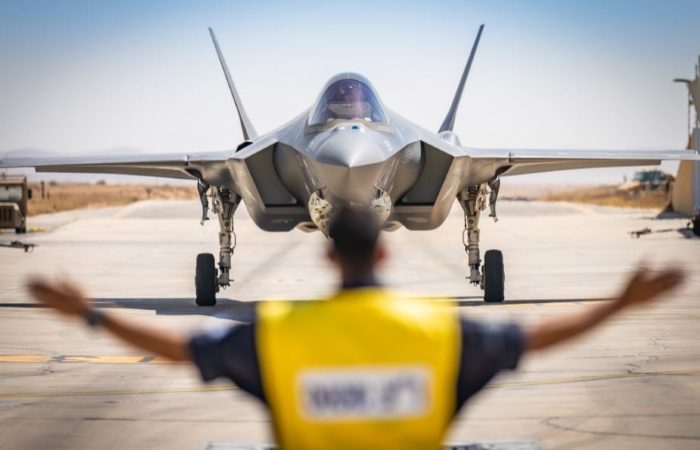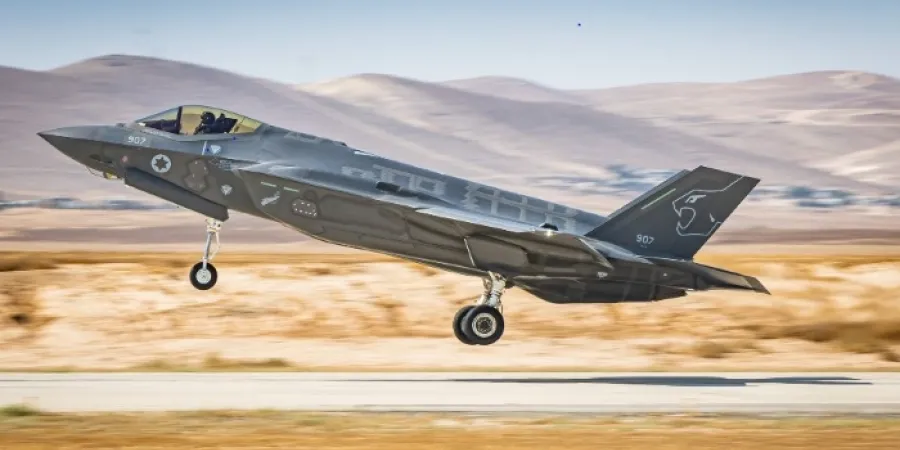Israel's second F-35I squadron now operational
After months of training and an intensive inspection of its capability to handle challenging scenarios, including a simulated war on all fronts, the 116th Squadron gets the green light to carry out operations
IsraelDefense
| 10/08/2020
The Israeli Air Force has announced that its second squadron of F-35I "Adir" fighters is officially operational following about six months of intensive preparations.
According to the IAF, the 116th Squadron, nicknamed "Lions of the South", was required to undergo a long process during which it gained experience in various fields, including scenarios it was required to face as part of preparations for the inspection that took place last week.
"The operational fitness inspection provides an official seal of approval for the operational capability of the 116th Squadron to carry out all the missions of the 'Adir' division. The squadron's tasks include its management during routine and periods of war, as well as maintaining functional continuity," explained the squadron's technical officer, identified only as Maj. Edi.
The squadron's personnel were not exposed in advance to the scenarios they had to face as part of the test week, in the same way that they will not always be able to anticipate what will happen during combat. "The inspection simulated the operational arena and the current regional tensions. Several scenarios led to a simulated war on all fronts, and aircrew members took off for missions in all of Israel's regions", said Maj. G, leader of the operational fitness inspection and a member of the squadron's aircrew.
A number of operational commands were also involved in the inspection process. "Various personnel from different departments in the IAF's HQ came to the squadron to examine us", said Maj. G. "During the IAF's continuous activity and combat, these people give operational commands to the different squadrons - the commands that describe the mission, the desired result and the policy of action set by the Commander of the IAF. We are required to take those operational commands and plan and execute them".
The operational fitness inspection simulated 72 hours of intensive combat. "We worked 24 hours a day, nonstop", said Maj. Edi. "Soldiers, officers and NCOs alike, worked for 16 hours a day and rested for the remaining eight. The squadron operated in shifts to simulate its activity during warfare".
Throughout the week, the squadron's technical department was tested in many different scenarios that can affect its way of functioning. "We dealt with situations of missile attacks, and were tested on our ability to handle them properly", said Maj. Edi. "When missiles hit the squadron, a fire broke out and there were injuries - they examined our decision-making process, management during combat, and ability to maintain functional continuity. That is just one example out of many. There wasn't a single scenario that we were not prepared for".
"The entire squadron participated in the operational fitness inspection, ranging from new soldiers who arrived this month to reserves who were specially recruited to take part", said Maj. G. "From the moment the squadron was established to this day, we were accompanied by a feeling of desire to be part of a team. We all want to succeed and be the best we possibly can. Throughout the past half-year, the 116th Squadron's personnel gave one hundred percent of their energy and abilities to ensure that it would be among the leading squadrons in the IAF. There is anticipation and a feeling of preparedness - we came prepared to the operational fitness and now get to prove ourselves".
"The next significant milestone will be our first operational mission," concluded Maj. G. "We are still a small squadron, and will continue to recruit new people and aircraft in the coming months".
Earlier this month, the IAF and the U.S. Air Force Central Command held a joint exercise involving their F-35 fighters to practice locating and neutralizing aerial and ground threats. Israel was the first country after the US to acquire the 5th generation aircraft.

After months of training and an intensive inspection of its capability to handle challenging scenarios, including a simulated war on all fronts, the 116th Squadron gets the green light to carry out operations
The Israeli Air Force has announced that its second squadron of F-35I "Adir" fighters is officially operational following about six months of intensive preparations.
According to the IAF, the 116th Squadron, nicknamed "Lions of the South", was required to undergo a long process during which it gained experience in various fields, including scenarios it was required to face as part of preparations for the inspection that took place last week.
"The operational fitness inspection provides an official seal of approval for the operational capability of the 116th Squadron to carry out all the missions of the 'Adir' division. The squadron's tasks include its management during routine and periods of war, as well as maintaining functional continuity," explained the squadron's technical officer, identified only as Maj. Edi.
The squadron's personnel were not exposed in advance to the scenarios they had to face as part of the test week, in the same way that they will not always be able to anticipate what will happen during combat. "The inspection simulated the operational arena and the current regional tensions. Several scenarios led to a simulated war on all fronts, and aircrew members took off for missions in all of Israel's regions", said Maj. G, leader of the operational fitness inspection and a member of the squadron's aircrew.
A number of operational commands were also involved in the inspection process. "Various personnel from different departments in the IAF's HQ came to the squadron to examine us", said Maj. G. "During the IAF's continuous activity and combat, these people give operational commands to the different squadrons - the commands that describe the mission, the desired result and the policy of action set by the Commander of the IAF. We are required to take those operational commands and plan and execute them".
The operational fitness inspection simulated 72 hours of intensive combat. "We worked 24 hours a day, nonstop", said Maj. Edi. "Soldiers, officers and NCOs alike, worked for 16 hours a day and rested for the remaining eight. The squadron operated in shifts to simulate its activity during warfare".
Throughout the week, the squadron's technical department was tested in many different scenarios that can affect its way of functioning. "We dealt with situations of missile attacks, and were tested on our ability to handle them properly", said Maj. Edi. "When missiles hit the squadron, a fire broke out and there were injuries - they examined our decision-making process, management during combat, and ability to maintain functional continuity. That is just one example out of many. There wasn't a single scenario that we were not prepared for".
"The entire squadron participated in the operational fitness inspection, ranging from new soldiers who arrived this month to reserves who were specially recruited to take part", said Maj. G. "From the moment the squadron was established to this day, we were accompanied by a feeling of desire to be part of a team. We all want to succeed and be the best we possibly can. Throughout the past half-year, the 116th Squadron's personnel gave one hundred percent of their energy and abilities to ensure that it would be among the leading squadrons in the IAF. There is anticipation and a feeling of preparedness - we came prepared to the operational fitness and now get to prove ourselves".
"The next significant milestone will be our first operational mission," concluded Maj. G. "We are still a small squadron, and will continue to recruit new people and aircraft in the coming months".
Earlier this month, the IAF and the U.S. Air Force Central Command held a joint exercise involving their F-35 fighters to practice locating and neutralizing aerial and ground threats. Israel was the first country after the US to acquire the 5th generation aircraft.



